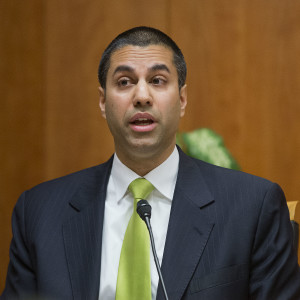Update: An FCC spokesman responded to the story.
Federal Communications Commissioner Ajit Pai revealed new details Wednesday about his office’s investigation into possible fraud in the agency’s Lifeline phone subsidy program for low income Americans, which found more than 35 percent of subscribers across the majority of states were enrolled using an unscrupulous override process meant to block duplicate enrollments.
During a briefing with reporters Wednesday, Pai explained how carriers have begun using an Independent Economic Household (IEH) override to enroll Lifeline subscribers after a database flags them as living at an address where a Lifeline subscriber already resides.
IEH overrides allow a carrier to certify a Lifeline enrollee is eligible for the $9.25 monthly subsidy simply by certifying they’re financially independent of another Lifeline subscriber who lives at the same address.
The override only requires customers to “check a box” according to FCC officials who briefed reporters Wednesday. Such enrollments accounted for one-third of all enrollments (4,291,647 people) between October 2014 and April 2016, or 35.3 percent.
“That’s more people than live in the state of Oregon,” Pai wrote in a letter to Universal Service Administrative Company (USAC) CEO Chris Henderson Wednesday. USAC administers the Lifeline program.
“And the price to the taxpayer is steep,” Pai continued, “just one year of service for these apparent duplicates costs taxpayers $476 million.”
In a letter to Henderson in May, Pai asked for more information about the override processes USAC has in place for carriers after they submit a Lifeline application to the National Lifeline Accountability Database. The database is designed to prevent duplicate enrollments in 44 participating states, and does not cover California — the state with the highest number of Lifeline subscribers.
Before enrolling subscribers, wireless providers — who essentially receive free business from the program — are supposed to submit the information of potential enrollees, including name, date of birth and Social Security numbers to the National Lifeline Accountability Database (NLAD) and verify they haven’t previously enrolled.
The request came after the FCC fined wireless provider Total Call Mobile more than $51 million in May for enrolling tens of thousands of duplicate and ineligible consumers — the largest fine the agency has ever issued a Lifeline provider. According to Pai’s letter, Total Call Mobile agents overrode the NLAD database for 99 percent of its new subscribers in the last quarter of 2014.
After the FCC ordered USAC to begin verifying overrides itself, carrier use of the previous override process — which essentially required carriers to simply press a button without further scrutiny from USAC — transitioned to three new override processes.
Pai highlighted two of those in his May letter to USAC, and the third — IEH overrides — Wednesday. According to data obtained by Pai’s office from USAC, after use of the previous override process dropped from over 260,000 to zero between October 2014 and February 2015 (when the changes were implemented), use of the other three overrides rose, with IEH overrides specifically rising from over 170,000 to 212,000 over the same period.
By April 2016, IEH overides rose to 280,559, or 42 percent of all Lifeline enrollments last month. Overrides in total among the 44 states participating in NLAD accounted for 5.8 million subscribers between October 2014 and April 2016.
“When 5.8 million out of 12 million — roughly 48 percent of the total number of enrollments — are the result of an override where the carrier essentially on its own say-so tells the FCC through USAC, ‘We pinky swear that this is a legitimate subscriber,’ it does make you wonder both as taxpayers and as people who are charged with administering this program what exactly is going on here,” Pai said Wednesday.
“We need to get to the bottom of it, and we need to route out the waste, fraud and abuse that’s persistent in the program for a long time after February 2015,” he added.
Total Call Mobile sales agents testified they made a practice of simply checking the boxes and even signing documents for potential subscribers after NLAD flagged them as duplicates — a practice Pai worries could still be happening.
“Given what happened in the Total Call Mobile case … it seems pretty clear to me that there are substantial problems with the way the program is being administered now, and that unscrupulous actors have no problem filling the vacuum, so to speak, when the enforcement mechanism isn’t robust,” Pai said.
An FCC spokesman responded to the details of the investigation in a Wednesday statement, pointing to the National Eligibility Verifier system included in this year’s Lifeline update as Chairman Tom Wheeler’s solution.
“The Lifeline program must be designed both to prevent abuses and to make sure that Lifeline is available to those that need it most, including the homeless population,” the spokesman told InsideSources, referencing the high number of Lifeline duplicate overrides naming homeless shelters as their addresses — a practice Total Call Mobile used often to push through overrides.
“A critical piece of the Lifeline reforms adopted by the majority of the commission in March included creation of an independent National Lifeline Eligibility Verifier, which will take the responsibility for verifying subscriber eligibility out of the hands of the provider and transfer it to a third party. Taking this determination away from the companies that stand to benefit financially will remove the program’s major remaining vulnerability to waste, fraud and abuse.”
Chairman Tom Wheeler previously characterized the current system of carriers certifying overrides as “the fox guarding the hen house,” and added he inherited the old system when he became chairman.
The plan calls for a proposal outlining the verifier system by December, and a deadline to have it up and running by 2019.

